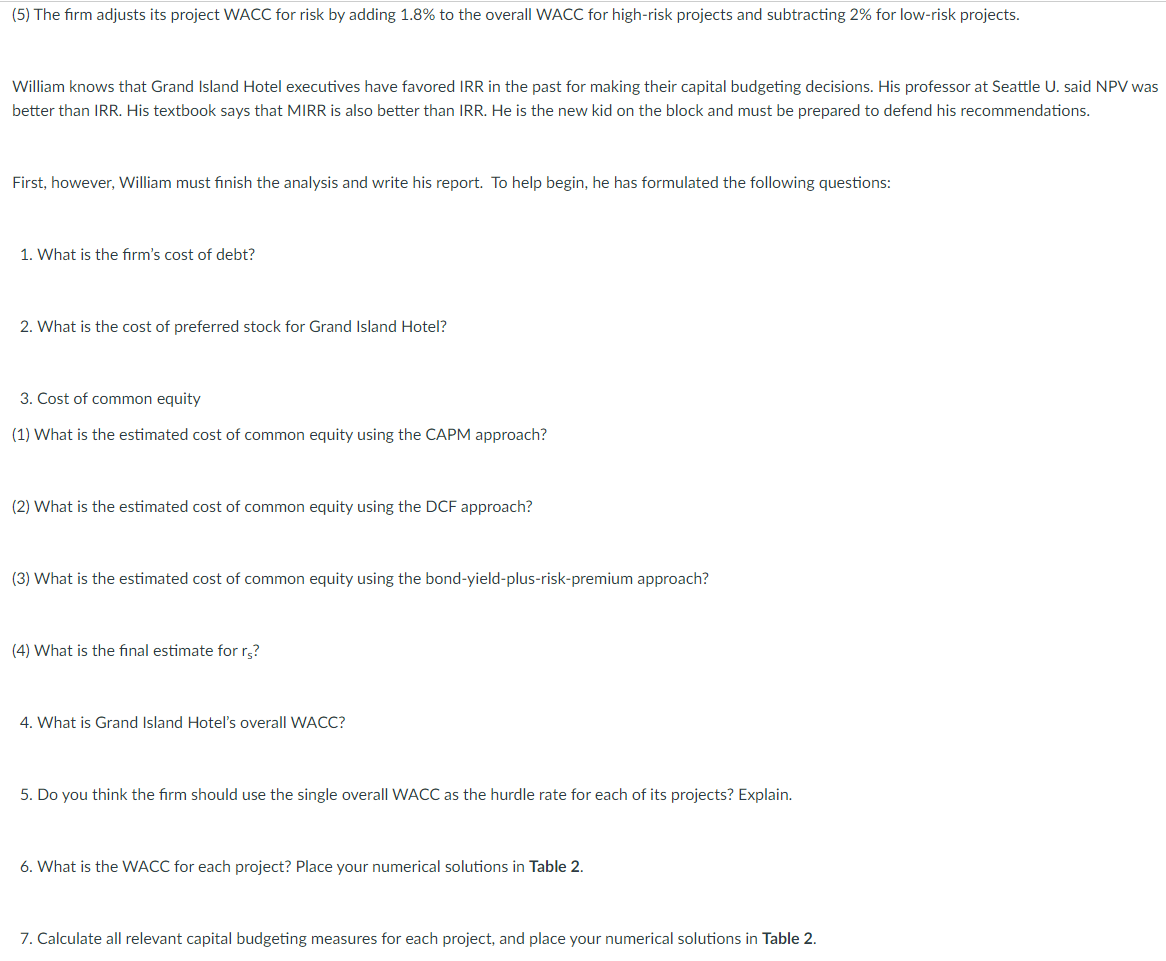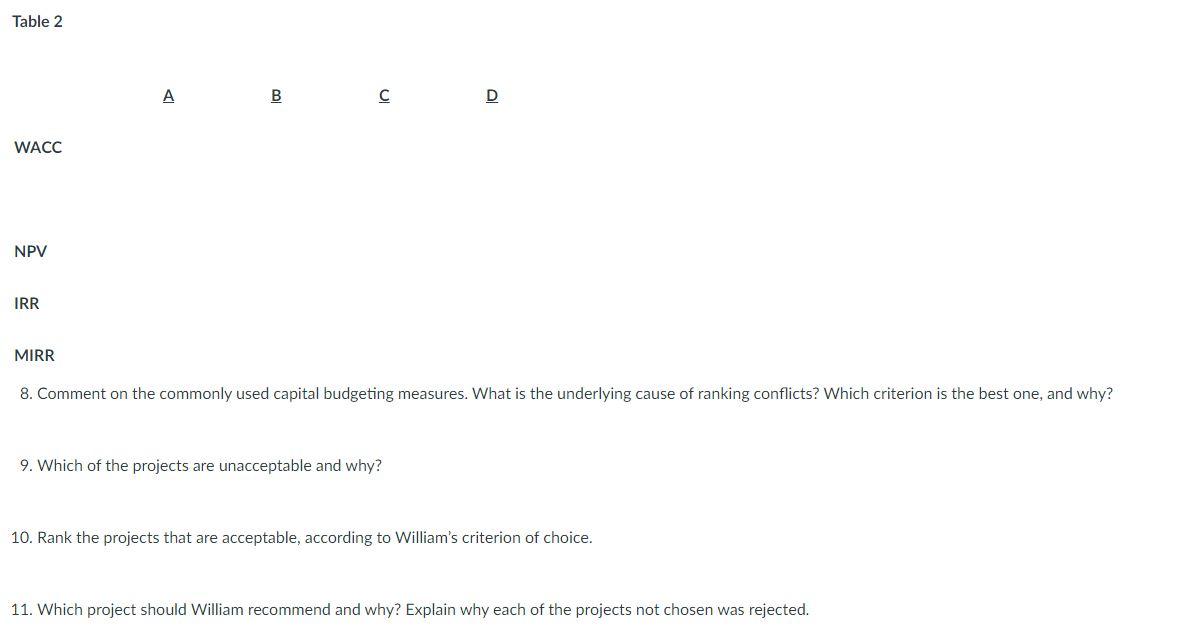



William was recently hired by Grand Island Hotel as a junior budget analyst. He is working for the Venture Capital Division and has been given for capital budgeting projects to evaluate. He must give his analysis and recommendation to the capital budgeting committee. William has a B.S. in accounting from CWU (2015) and passed the CPA exam (2018). He has been in public accounting for several years. During that time he earned an MBA from Seattle U. He would like to be the CFO of a company someday--maybe Grand Island Hotel-- and this is an opportunity to get onto that career track and to prove his ability. As William looks over the financial data collected, he is trying to make sense of it all. He already has the most difficult part of the analysis complete - the estimation of cash flows. Through some internet research and application of finance theory, he has also determined the firm's beta. Here is the information that William has accumulated so far: The Capital Budgeting Projects He must choose one of the four capital budgeting projects listed below: Table 1 shows the expected after-tax operating cash flows for each project. All projects are expected to have a 4 year life. The projects differ in size (the cost of the initial investment), and their cash flow patterns are different. They also differ in risk as indicated in the above table. The capital budget is $22 million and the projects are mutually exclusive. Capital Structures Grand Island Hotel has the following capital structure, which is considered to be optimal: Cost of Capital William knows that in order to evaluate the projects he will have to determine the cost of capital for each of them. He has been given the following data, which he believes will be relevant to his task. (1)The firm's tax rate is 38%. (2) Grand Island Hotel has issued a 9\% semi-annual coupon bond with 15 years term to maturity. The current trading price is $960. (3) The firm has issued some preferred stock which pays an annual 8.5% dividend of $100 par value, and the current market price is $98. (4) The firm's stock is currently selling for $88 per share. Its last dividend (D0) was $4.5, and dividends are expected to grow at a constant rate of 7.5%. The current risk free return offered by Treasury security is 2.5%, and the market portfolio's return is 8%. Grand Island Hotel has a beta of 2.1. For the bond-yield-plus-riskpremium approach, the firm uses a risk premium of 3.9%. (5) The firm adjusts its project WACC for risk by adding 1.8% to the overall WACC for high-risk projects and subtracting 2% for low-risk projects. William knows that Grand Island Hotel executives have favored IRR in the past for making their capital budgeting decisions. His professor at Seattle U. said NPV wa better than IRR. His textbook says that MIRR is also better than IRR. He is the new kid on the block and must be prepared to defend his recommendations. First, however, William must finish the analysis and write his report. To help begin, he has formulated the following questions: 1. What is the firm's cost of debt? 2. What is the cost of preferred stock for Grand Island Hotel? 3. Cost of common equity (1) What is the estimated cost of common equity using the CAPM approach? (2) What is the estimated cost of common equity using the DCF approach? (3) What is the estimated cost of common equity using the bond-yield-plus-risk-premium approach? (4) What is the final estimate for rs ? 4. What is Grand Island Hotel's overall WACC? 5. Do you think the firm should use the single overall WACC as the hurdle rate for each of its projects? Explain. 6. What is the WACC for each project? Place your numerical solutions in Table 2. 7. Calculate all relevant capital budgeting measures for each project, and place your numerical solutions in Table 2. 8. Comment on the commonly used capital budgeting measures. What is the underlying cause of ranking conflicts? Which criterion is the best one, and why? 9. Which of the projects are unacceptable and why? 10. Rank the projects that are acceptable, according to William's criterion of choice. 11. Which project should William recommend and why? Explain why each of the projects not chosen was rejected. William was recently hired by Grand Island Hotel as a junior budget analyst. He is working for the Venture Capital Division and has been given for capital budgeting projects to evaluate. He must give his analysis and recommendation to the capital budgeting committee. William has a B.S. in accounting from CWU (2015) and passed the CPA exam (2018). He has been in public accounting for several years. During that time he earned an MBA from Seattle U. He would like to be the CFO of a company someday--maybe Grand Island Hotel-- and this is an opportunity to get onto that career track and to prove his ability. As William looks over the financial data collected, he is trying to make sense of it all. He already has the most difficult part of the analysis complete - the estimation of cash flows. Through some internet research and application of finance theory, he has also determined the firm's beta. Here is the information that William has accumulated so far: The Capital Budgeting Projects He must choose one of the four capital budgeting projects listed below: Table 1 shows the expected after-tax operating cash flows for each project. All projects are expected to have a 4 year life. The projects differ in size (the cost of the initial investment), and their cash flow patterns are different. They also differ in risk as indicated in the above table. The capital budget is $22 million and the projects are mutually exclusive. Capital Structures Grand Island Hotel has the following capital structure, which is considered to be optimal: Cost of Capital William knows that in order to evaluate the projects he will have to determine the cost of capital for each of them. He has been given the following data, which he believes will be relevant to his task. (1)The firm's tax rate is 38%. (2) Grand Island Hotel has issued a 9\% semi-annual coupon bond with 15 years term to maturity. The current trading price is $960. (3) The firm has issued some preferred stock which pays an annual 8.5% dividend of $100 par value, and the current market price is $98. (4) The firm's stock is currently selling for $88 per share. Its last dividend (D0) was $4.5, and dividends are expected to grow at a constant rate of 7.5%. The current risk free return offered by Treasury security is 2.5%, and the market portfolio's return is 8%. Grand Island Hotel has a beta of 2.1. For the bond-yield-plus-riskpremium approach, the firm uses a risk premium of 3.9%. (5) The firm adjusts its project WACC for risk by adding 1.8% to the overall WACC for high-risk projects and subtracting 2% for low-risk projects. William knows that Grand Island Hotel executives have favored IRR in the past for making their capital budgeting decisions. His professor at Seattle U. said NPV wa better than IRR. His textbook says that MIRR is also better than IRR. He is the new kid on the block and must be prepared to defend his recommendations. First, however, William must finish the analysis and write his report. To help begin, he has formulated the following questions: 1. What is the firm's cost of debt? 2. What is the cost of preferred stock for Grand Island Hotel? 3. Cost of common equity (1) What is the estimated cost of common equity using the CAPM approach? (2) What is the estimated cost of common equity using the DCF approach? (3) What is the estimated cost of common equity using the bond-yield-plus-risk-premium approach? (4) What is the final estimate for rs ? 4. What is Grand Island Hotel's overall WACC? 5. Do you think the firm should use the single overall WACC as the hurdle rate for each of its projects? Explain. 6. What is the WACC for each project? Place your numerical solutions in Table 2. 7. Calculate all relevant capital budgeting measures for each project, and place your numerical solutions in Table 2. 8. Comment on the commonly used capital budgeting measures. What is the underlying cause of ranking conflicts? Which criterion is the best one, and why? 9. Which of the projects are unacceptable and why? 10. Rank the projects that are acceptable, according to William's criterion of choice. 11. Which project should William recommend and why? Explain why each of the projects not chosen was rejected










